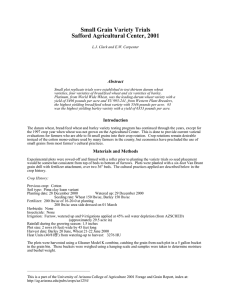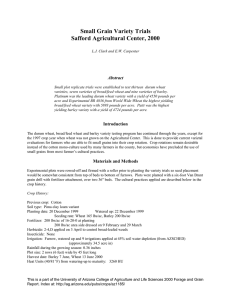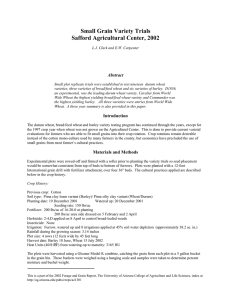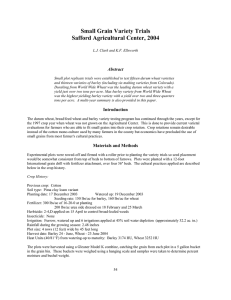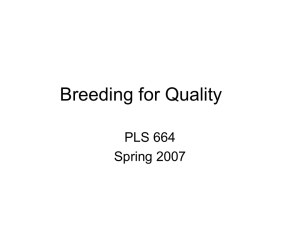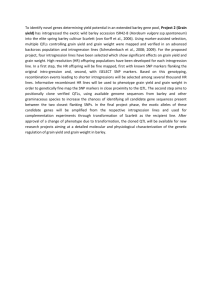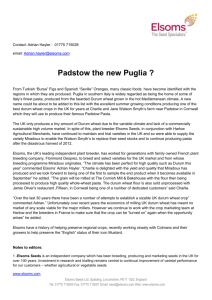Small Grain Variety Trials Safford Agricultural Center, 1999 Abstract
advertisement
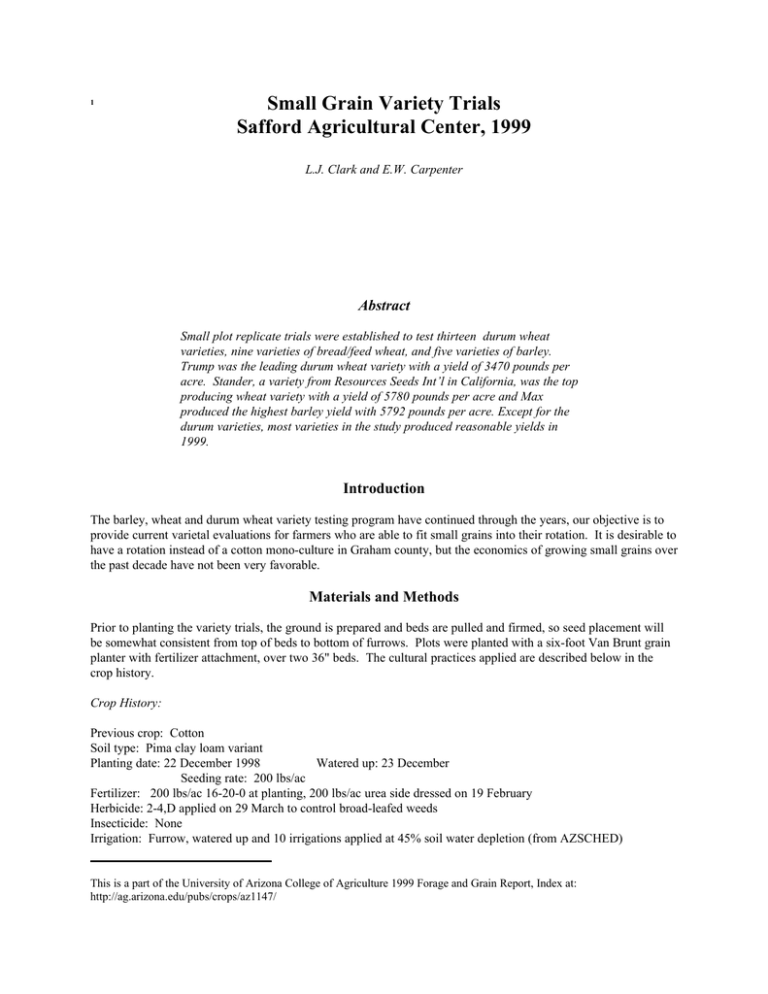
1 Small Grain Variety Trials Safford Agricultural Center, 1999 L.J. Clark and E.W. Carpenter Abstract Small plot replicate trials were established to test thirteen durum wheat varieties, nine varieties of bread/feed wheat, and five varieties of barley. Trump was the leading durum wheat variety with a yield of 3470 pounds per acre. Stander, a variety from Resources Seeds Int’l in California, was the top producing wheat variety with a yield of 5780 pounds per acre and Max produced the highest barley yield with 5792 pounds per acre. Except for the durum varieties, most varieties in the study produced reasonable yields in 1999. Introduction The barley, wheat and durum wheat variety testing program have continued through the years, our objective is to provide current varietal evaluations for farmers who are able to fit small grains into their rotation. It is desirable to have a rotation instead of a cotton mono-culture in Graham county, but the economics of growing small grains over the past decade have not been very favorable. Materials and Methods Prior to planting the variety trials, the ground is prepared and beds are pulled and firmed, so seed placement will be somewhat consistent from top of beds to bottom of furrows. Plots were planted with a six-foot Van Brunt grain planter with fertilizer attachment, over two 36" beds. The cultural practices applied are described below in the crop history. Crop History: Previous crop: Cotton Soil type: Pima clay loam variant Planting date: 22 December 1998 Watered up: 23 December Seeding rate: 200 lbs/ac Fertilizer: 200 lbs/ac 16-20-0 at planting, 200 lbs/ac urea side dressed on 19 February Herbicide: 2-4,D applied on 29 March to control broad-leafed weeds Insecticide: None Irrigation: Furrow, watered up and 10 irrigations applied at 45% soil water depletion (from AZSCHED) This is a part of the University of Arizona College of Agriculture 1999 Forage and Grain Report, Index at: http://ag.arizona.edu/pubs/crops/az1147/ (approximately 40 acre in) Rainfall during the growing season: 2.8 inches Plot size: 2 rows (6 feet) wide by 45 feet long Harvest date: Barley 22 June, Wheat 29 June 1998 Heat Units (40/81EF) from watering-up to harvest: Barley - 3491 HU, Wheat - 3751 HU The plots were harvested using a Gleaner Model L combine, catching the grain from each plot in a 5 gallon bucket in the grain bin. These buckets were weighed using a hanging scale and samples were taken to determine moisture and bushel weight. Results and Discussion Results of the durum wheat study are found in Table 1. For some reason, this trial didn’t take off and grow in the early spring and the yields show it. The highest yielding variety didn’t yield as high as the lowest yielding variety in 1998 (1). Yields as high as 4 tons per acre are achieved in other parts of the county on a regular basis, but on the salty soils of the Agricultural Center, this is a rare event. Trump, a new variety from World Wide Wheat, produced the highest yield at 3470 pounds per acre. Bushel weights were about a pound per bushel lighter than in the previous year, but 3 to 4 pounds lighter that our bread/feed wheat study. Kernal weights and plant heights were also much lower than last year indicating that the plants didn’t thrive in 1999. The interesting part was the percent protein, they were almost 2% higher this year than last. And, HVAC were not determined this year because no kernels were found that had yellow berry. Bread and feed wheat variety studies are reported in Table 2. The highest yielding variety, Stander (Resources Seeds International, Woodland, CA) was placed in the trial because of the strength of it’s sister line, RSI 5, which was the highest yielding variety in 1998. Yields were not as high in 1999 as in the previous year, but were in the acceptable range. Bushel weights and percent protein were much higher than last year, whereas kernel weight and plant height were lower. As with the durum wheat, no yellow berry was seen in any of the varieties, hence a HVAC analysis was not preformed. Similar to last year’s trial, the highest yielding variety had the lowest protein percent. The interesting thing to note is that another sister line, Bonus, yielded within a couple of hundred pound per acre of the top variety, but had a protein content above the average. Table 3 contains the yield and agronomic information on the barley variety study. Few varieties were obtained for testing, but of those tested Max produced the highest yield. Comparing with last year, this year’s yields were much lower, plant heights were much shorter and kernel weights were much lower. The cool spring and early summer probably boosted the yields above our normal averages, but conditions were not as good as 1998. References 1. Clark, L.J. and E.W. Carpenter. 1998. Small grain variety trials Safford Agricultural Center, 1998. Forage and Grain, A College of Agriculture Report, The University of Arizona, Tucson, AZ. Series P-114, pp. 97-101. 2. Ottman, M.J. and M.T. Rogers. 1998. Small grain variety evaluation at Marana, Maricopa and Yuma, 1998. Forage and Grain, A College of Agriculture Report, The University of Arizona, Tucson, AZ. Series P-114, pp. 102-112. Table 1. Yield and other agronomic data from the durum wheat variety trial, Safford Agricultural Center, 1998-9. Variety Yield per acre @10%M Bushel Weight % Moisture % Protein 1000 Kernal Weight Plant Height Stems per Square Foot Trump D2656 www 3469.9 a 1 60.5 a 6.50 b 15.8 38.8 ab 31.5 a 43.5 a Topper D1128 www 2918.0 ab 60.5 a 7.03 ab 16.2 38.3 ab 29.5 ab 37.0 a Utopia www 2858.2 ab 61.0 a 6.85 ab 15.8 38.8 ab 26.5 b 38.5 a Platinum D9430www 2689.9 b 60.3 a 7.85 a 14.2 40.3 ab 25.0 b 37.3 a Deluxe D1856 www 2576.2 b 60.3 a 7.45 ab 16.5 38.9 ab 26.3 b 44.5 a Crown D3117 www 2531.8 b 59.8 a 6.85 ab 15.1 40.5 ab 25.8 b 39.5 a Cortez wpb 2150.9 bc 60.0 a 7.28 ab 16.3 41.8 ab 28.0 ab 41.8 a Kofa wpb 1664.9 cd 60.3 a 7.12 ab 14.6 43.8 ab 27.5 ab 29.8 a Kronos apb 1617.3 cd 61.0 a 7.05 ab 16.0 39.8 ab 25.8 b 40.3 a www 1579.5 cd 59.8 a 7.35 ab 16.2 37.0 b 27.8 ab 42.3 a Mohawk wpb 1425.7 cd 61.0 a 7.08 ab 15.6 43.3 ab 27.3 ab 43.3 a Ocotillo apb 1185.3 cd 60.0 a 7.53 ab 17.1 40.0 ab 27.8 ab 42.3 a Tacna wpb 1100.0 59.8 a 7.70 a 16.6 39.8 ab 26.5 b 41.2 a Rico D5318 d Average 2136 60.3 7.2 15.8 40.1 27.3 40.1 LSD(05) 684.4 1.44 0.93 -- 5.63 3.83 14.48 CV (%) 22.34 1.66 9.01 -- 9.81 9.79 25.21 1. Values followed by the same letter, within a column, are not significantly different at the 95% level of confidence using Duncan’s Multiple Range test. Table 2. Yield and other agronomic data from the wheat variety trial, Safford Agricultural Center, 1998-9. Variety Yield per acre @10%M Bushel Weight % Moisture % Protein 1000 Kernal Weight Plant Height Stems per Square Foot Stander rsi 5780.0 a1 63.8 a 7.85 a 13.9 39.0 b 28.3 ab 33.8 a Bonus rsi 5505.4 ab 62.5 a 7.13 a 15.1 42.4 ab 27.0 bcd 41.8 a Rich www 5474.8 ab 63.3 a 7.78 a 15.2 41.3 ab 25.8 cd 37.5 a BR 8631 www 5376.3 ab 63.3 a 7.58 a 15.1 39.8 b 26.8 bcd 52.3 a Cavalier www 5349.7 ab 63.5 a 7.78 a 15.4 40.8 b 26.8 bcd 39.3 a rsi 4777.5 bc 64.0 a 8.25 a 14.2 40.0 b 29.8 a 50.3 a 4769.2 ab 63.8 a 7.75 a 16.1 44.5 a 25.3 d 33.0 a wpb 4396.5 c 63.8 a 8.30 a 15.8 40.6 b 27.3 bc 38.5 a www 4266.3 c 63.0 a 8.33 a 14.3 41.0 b 28.3 ab 40.0 a RSI 5 Yecora Rojo Brooks BR 9246 Average 5077.3 63.4 7.86 15.0 41 27.2 40.7 LSD(05) 799.0 1.4 1.4 -- 3.1 1.6 18.0 CV (%) 10.8 1.56 12.5 -- 5.2 4.1 30.3 1. Values followed by the same letter, within a column, are not significantly different at the 95% level of confidence using Duncan’s Multiple Range test. Table 3. Yield and other agronomic date from the barley variety trial grown on the Safford Agricultural Center, 1998-99. Variety Yield/ac @ 10% M Percent Moisture Bushel Weight 1000 kernal weight Plant Height Max 5791.6 a1 11.5 a 53.5 a 42.2 a 23.3 a Gustoe 5282.9 ab 11.7 a 55.0 a 42.8 a 23.8 a Nebula 4516.4 b 11.3 a 54.0 a 44.3 a 22.5 a Baretta 4366.5 b 11.7 a 54.7 a 41.0 a 22.5 a BA 2391 3065.3 c 11.5 a 54.0 a 46.0 a 21.8 a Average 4604.6 11.5 54.3 43.3 22.7 LSD(05) 1042.7 0.49 1.73 7 2.54 14.7 2.78 2.07 10.5 7.26 CV(%) 1. Values followed by the same letter, within a column, are not significantly different at the 95% level of confidence using Duncan’s Multiple Range test.
